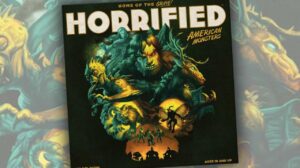Dear old Grandpa. He’s gone to his reward, leaving us his farm in Stardew Valley. We won’t have long to mourn his passing, though. He’s only given us a year to fulfill four goals and restore the Community Center. It will be a busy four seasons, spent making friends and collecting all the resources we need, all while contending with the evil Joja Corporation.
Knowledge of the video game is not necessary to play or enjoy Stardew Valley The Board Game (known here as SV: B as opposed to the video game, SV: V). The rules, objectives, and gameplay are complete without any previous knowledge. I will say, however, that my first play of the game was made more enjoyable by the one person in the group who had played SV: V. Her running commentary on the objectives, resources, and especially the characters, helped make for a fun evening.
I’ll discuss some differences between the cardboard and video versions of the game at the end of this review.
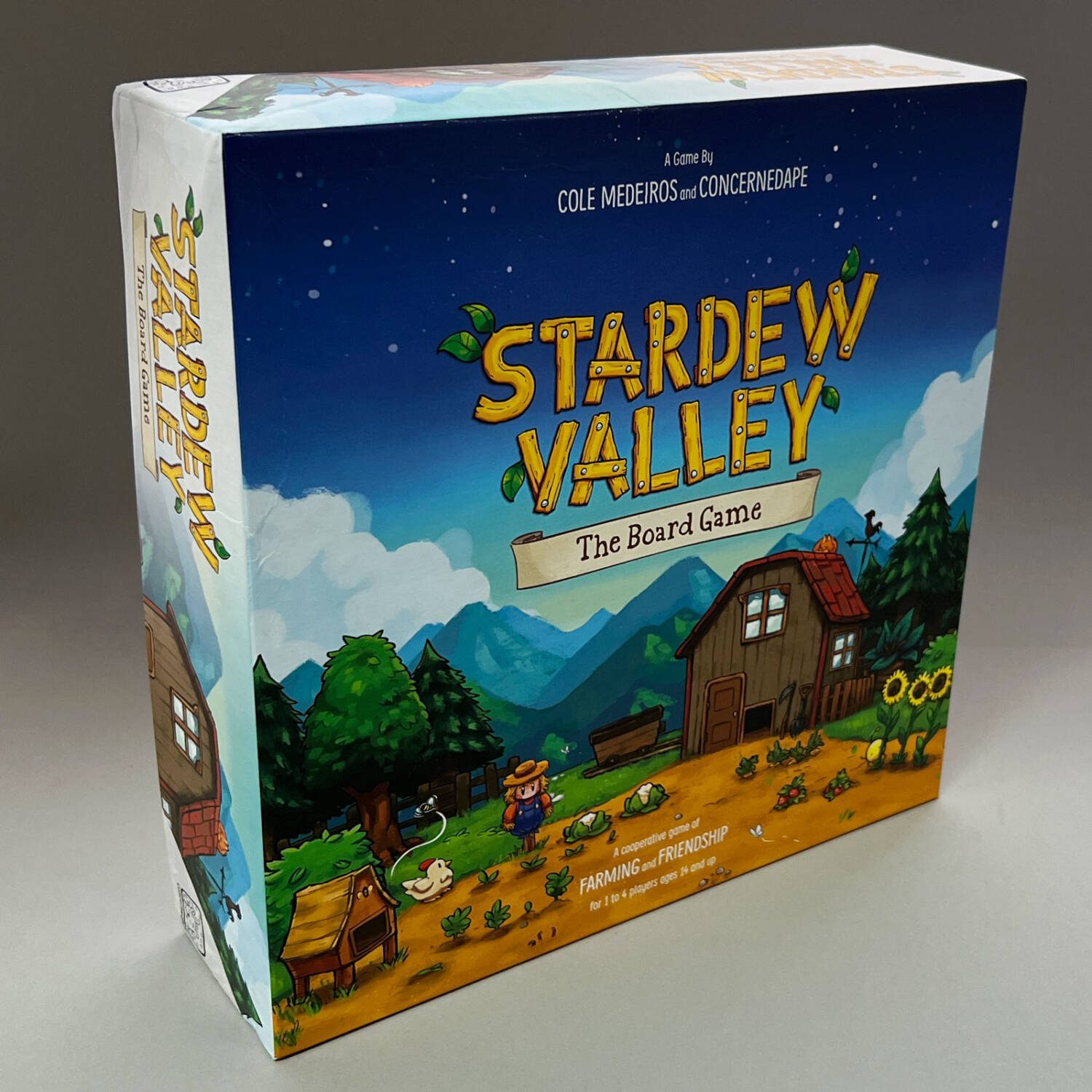
In keeping with the non-confrontational aspects of the video game, SV: B is a cooperative game. To win, players will need to work cooperatively to meet the conditions on all four of Grandpa’s Goals. You’ll also need to meet the requirements of the six rooms in the Community Center, all in four short seasons. While Grandpa’s Goals are all visible at the start of the game, you’ll need to pay to discover the Community Center conditions.
Setup
You will start the game by setting up the board for the Spring. Lay out the Spring tiles, facedown, along the pathways on board. These plain-backed tiles are forageables and you’ll place them atop the mushrooms on the board. Then you’ll place the wood tiles, with trees on the back, on the tree stumps.
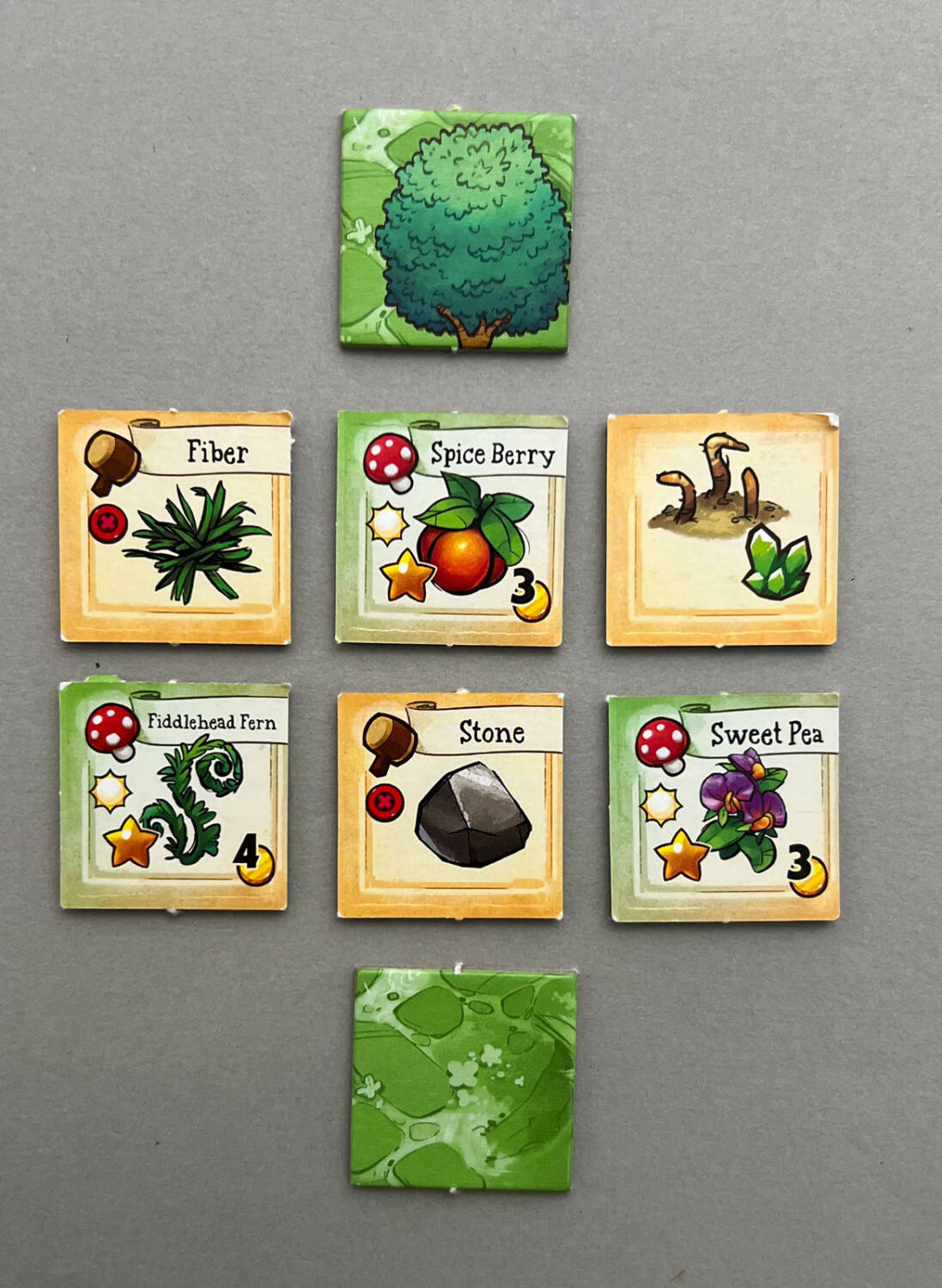
Randomly select four Spring season cards face down, then place the End of Spring card underneath them. Do the same for the Summer, Fall, and Winter season cards. (The game recommends specific cards for your first game.)
You’ll then choose four of the eight Grandpa’s Goals cards and place them along the upper left corner of the board.

Based on these goals, players will then choose a player mat and the starting tool cards that best match up with those goals. Need to clear 12 levels of the mine or donate to the museum? Choosing the pick axe would be a good idea. Need to catch those pesky Legendary Fish? Take a look at that fishing pole. Need lots of money? That watering can will help you harvest more produce that you can sell for money.
Next, you’ll randomly choose one of the four cards for each of the six rooms that need to be restored in the Community Center. Place them face-down on their corresponding places at the top right of the board.

Take the Mine Level cards and put them in order, from 1-12. Place them face up on the Mine area with the 1 at the top. Then you’ll shuffle the Mine Map cards and turn one face up. Shuffle the Villagers deck and set it face-down to the side as well.
Randomly choose five fish tiles from the bag and place them along The Fish Track in the bottom left of the board.
Take one Turnip from the (really nice) organizer and place it on the #2 spot in your Garden.
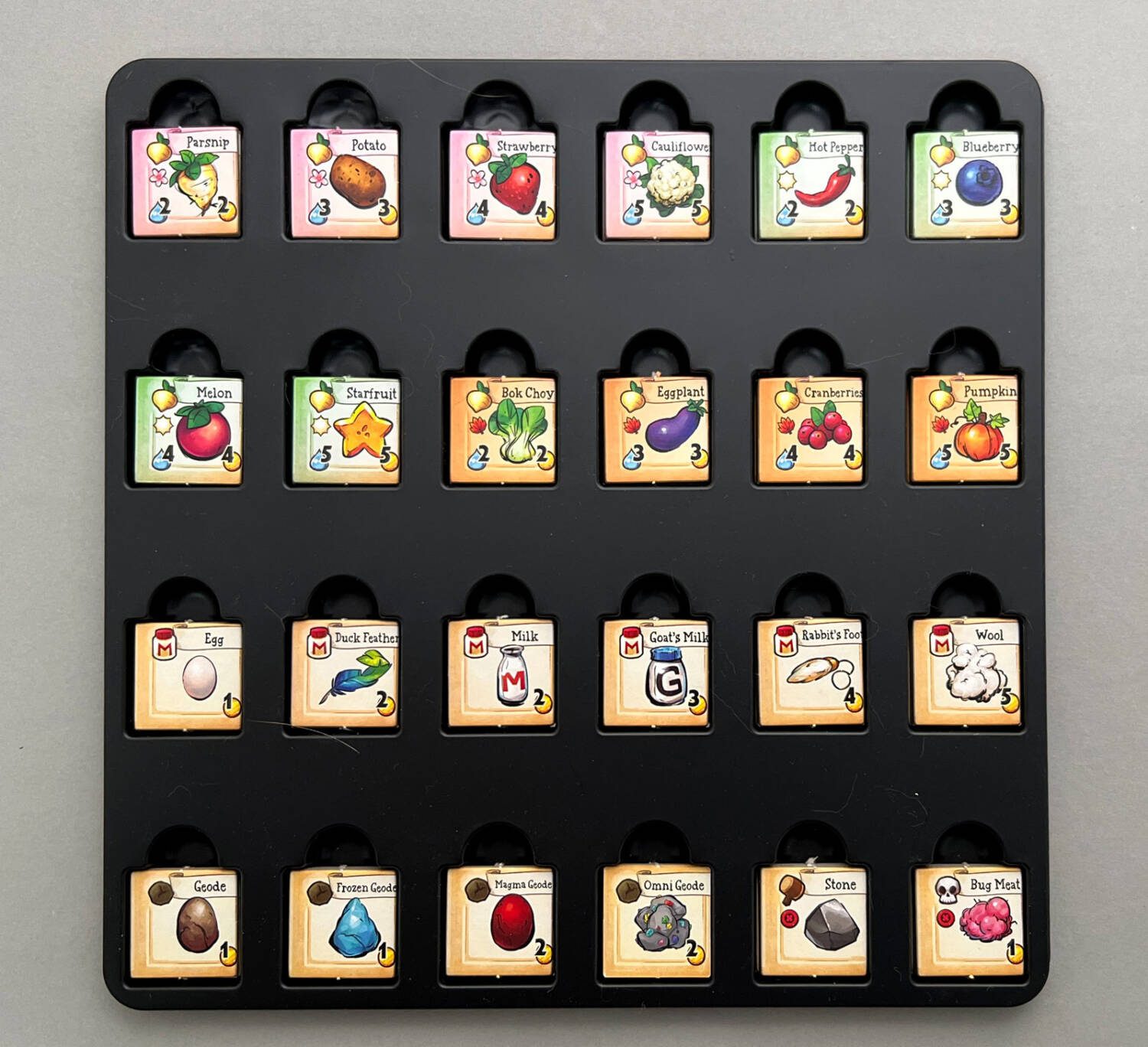
Place the mineral and artifact tiles in their bag and set them to the side of the Mine. Set out all the animal and farm building tiles and set them close to the barn.

Take three Gold for your communal starting cash. Then place your pawns on the Farmhouse and choose a starting player.
Playing the Game
On a turn, each player will start at one of the seven locations on the board. They can take one of the actions in that area, then either take the same or another action in that location, or move along the path to a second location and take a single action there.

Since you’ll need money for most things in the game, let’s say you start your turn’s two actions by going to Town to buy seeds and plant them at the farm. For your second action, you’ll go to the Farm to water the crops. Watering crops moves all planted crop tiles to the right by one space—although watering can upgrades will increase how many crops move in this way.
As you move from one area to another, you’ll be able to claim one of the face-down forage tiles in the quadrants on either side of your path. These will go onto one of the six available spots on your player board.
Specific actions allow you to sell these crops and foragables—and anything else on your player board—for gold coins.
The other currency in the game is Hearts. The most common way to earn Hearts is to take the Make Friends action in Town—provided you have the right item on your player board to bribe them with gift to them. Here, you’ll draw the top card from the face-down Villager’s deck and review their likes and dislikes.

In the upper left column are the items they hate and, therefore, cannot be given. On the left, are the items they love. If you only have items they hate, they will not be your friend and their card is discarded. If you have something they neither hate nor love, they’ll become your friend and grant you one Heart. If you have an item they love, they’ll earn you two Hearts. If you give them an item they love and the current season is the one they were born in, you’ll get three Hearts.
Three Hearts is a big deal in SV: B.
For instance, three Hearts are needed to reveal each of the six Community Center bundles/goals. These bundles will include a specific season’s forageables, fish, resources, hearts, and gold coins.
The Mining and Fishing actions both require a dice roll. Each floor of the mine offers different possibilities, both for the type of items you might find and the monsters you may encounter (and the damage they’ll do). Likewise, you’ll need to roll to learn what kind of geodes Clint opens up for you at his forge before you can donate them to the Museum. Fish tiles—for Lake, River and Ocean fish—are all laid out together on the five tile spaces at the bottom left corner of the board. There are also Trash tiles that you’ll need to get rid of as well.
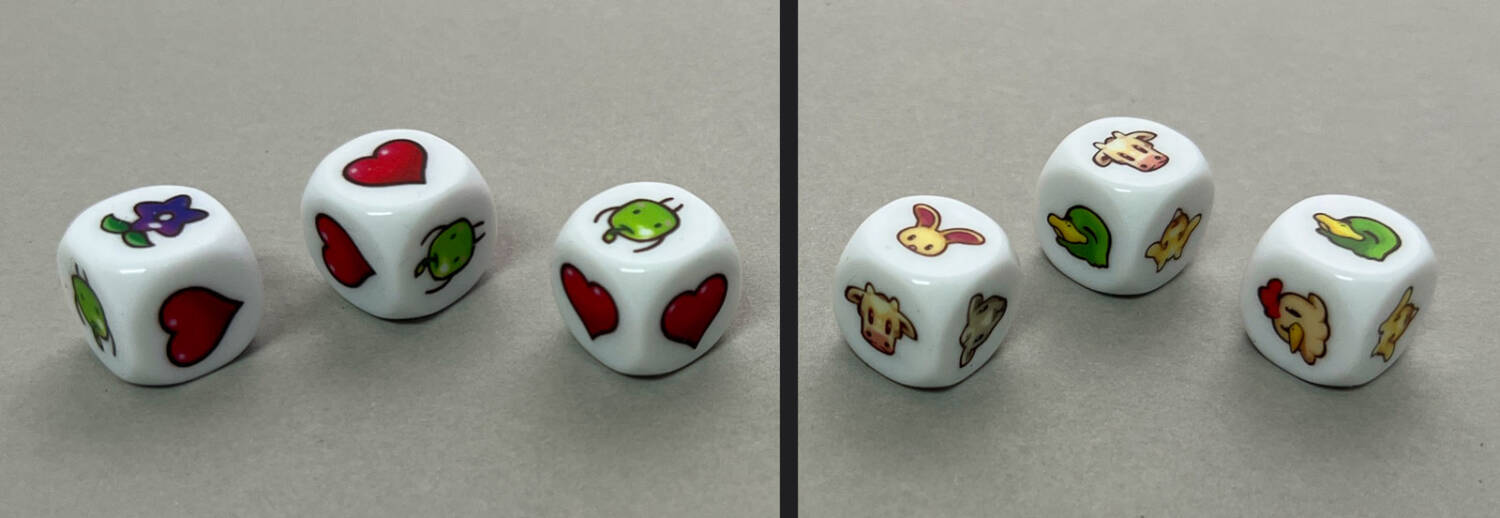
If you need to collect animal produce, you’ll first have to forage enough wood and earn enough money to build a barn and buy the animal. You’ll roll dice to see which animals (Goats, Chickens, or Cows) are producing that turn and collect goods—or not—accordingly.
Once all players have taken their two actions for the round, you’ll return your player tokens to the Farmhouse. You’ll turn over the next card for the current season and resolve the icons.
At the end of a season, remove all remaining forage tokens and set out the tiles for the next season. Each player then receives two random Professional upgrade cards of their choosing, keeping one and returning the other to the box.
Play continues until you reveal the fourth Winter card and each player takes their final set of actions. If you’ve managed to fulfill all four of Grandpa’s Goals and the six bundles for the Community Center, you win the game.
Thoughts
For co-op board game fans like me, there’s a lot to like about SV: B. Despite its cartoony graphics, this is a well-designed, challenging game to win. For fans of the SV: V, you’ll recognize much of what’s in the game. The places, Villagers, and the artwork are the same as in the video game. The idea of, and the steps required, to complete Grandpa’s Goals and the Community Center bundles will all make sense.
The essential element here is that Eric Barone (aka ConcernedApe), the designer of SV: V players, was one of the two designers of the board game.
Having now played the video game, I’m impressed with how many of the video game elements are included in a foreshortened cardboard version (the cardboard version takes place over a single year; the video game is open-ended). I’ve also been impressed at how familiar the two games feel. Barone’s involvement meant that an intellectual property (IP) wasn’t just handed off to a company looking to make a quick buck at the expense of the integrity of the original game.
As for the game itself, about midway through each game I’ve played, we’ve all agreed there was no way we were ever going to win. We lacked the hearts necessary to turn over the Community Center bundles (never mind having the resources to fulfill them) and money was tight. Then, somewhere in the third season, the game would turn around. By the middle of the final season, we thought we had a chance after all. Our first two games were lost on the final turn of the last player—and another game was won on another last turn.
That type of tension has kept everyone I’ve played with engaged in the game, regardless of their history with the IP. And, given that my three-player games have averaged between 3-4 hours each, that speaks to just how well designed Stardew Valley: B is.
That isn’t to say it’s a perfect game. As someone who is not a fan of dice games, the dice here strike me as frustratingly random. (Yes, I know there’s randomness in Stardew Valley: V, but dice rolls feel different to me.) Also, there are only eight cards to choose from for Grandpa’s four goals, meaning there’s bound to be repetition here. (After one game, we decided to House Rule the “Capture Legendary Fish” goal as being too difficult/random to complete. That left us with seven cards to choose from.)
These annoyances aside, SV: B is a game anyone who enjoys co-op games should be looking into. The game scales well from 1-4 players—although with our 3 player games each taking 3+ hours, I’m not sure I’d ever play it with 4 players. (None of the games felt like they’d taken that long to play. Much like My Father’s Work, another 3+ hour game my group and I have enjoyed playing, the game moves along quickly, so it feels like we’ve only played for a fraction of that time.
I went into SV: B foolishly not expecting much. I was happily proven wrong and am willing to play it whenever it’s suggested. Give it a try; I think you’ll probably feel the same.




